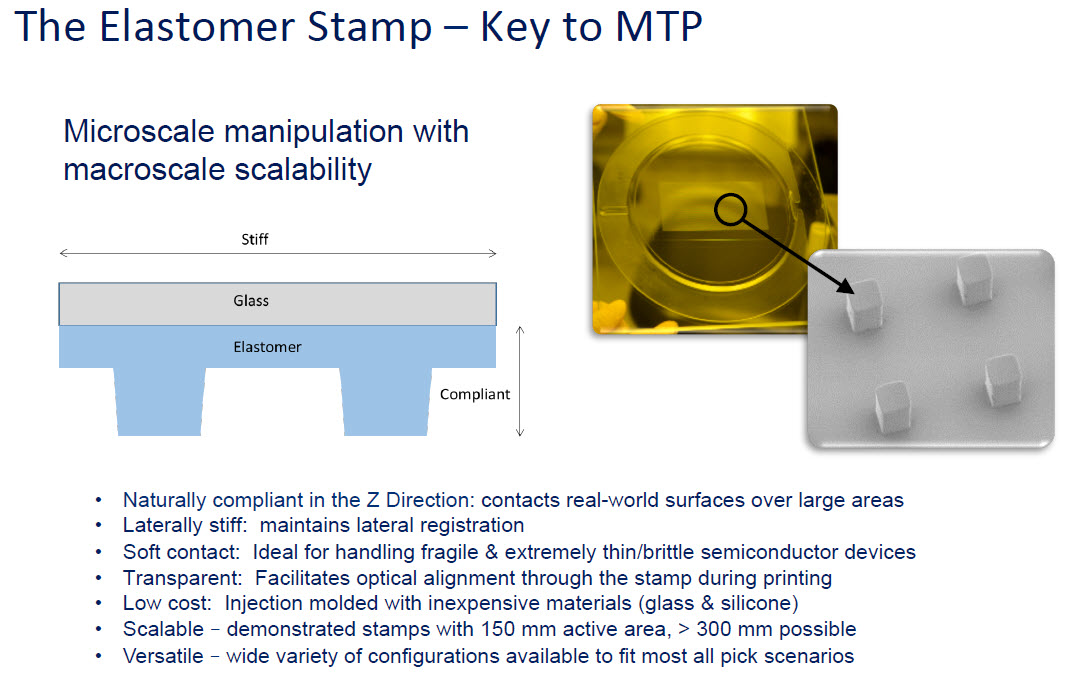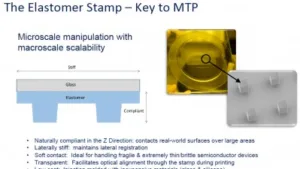 Kyle Benkendorfer is CEO and founder of X-Celeprint. The company can print LEDs onto flexible or transparent substrates and the company can also print micro-ICs and it can print sensors such as ToF sensors. The company can also make a package that can be put on a backplane.
Kyle Benkendorfer is CEO and founder of X-Celeprint. The company can print LEDs onto flexible or transparent substrates and the company can also print micro-ICs and it can print sensors such as ToF sensors. The company can also make a package that can be put on a backplane.
The company has been working on microLEDs for nine to ten years and has shown devices since 2009 and worked on printable backplanes for OLEDs. The business model is development and ip licensing although it has some manufacturing and it has a plan to build products itself. The firm is based in Cork, Ireland in the Tyndall National Institute which has very good clean rooms. The company also has facilities in Micross in Research Triangle Park in North Carolina.

Berkendorfer said that the firm’s technology uses an elastomer stamp which is very cheap and at the moment each pass of the stamp takes around 30 seconds. However, equipment makers have suggested this could be speeded up to 8-10 seconds. The company has licensed ip from the University of Illinois and Semprion as well as using its own technology. LED devices are made ‘placement ready’ and then the transfer process moves the device onto the final backplane.
The elastomer material used to stap is put on glass as a backing and the size could be 300 or 450mm stamps. The elastomer can pick up many shapes including long skinny devices. Devices can be as small as 3 x 3 x 1 micron. Benkendorfer said that the company may be able to go down to thinner and smaller, even down to 1 micron square. Brittle materials are OK and even InP lasers (which are said to be very brittle).
The yield is more than 99.9% using 64 x 64 arrays in a lab, but this could be 99.999% or 99.9999% in a production environment. The process can print onto plastic, glass, ceramic, semiconductors and many other types of material.
Benkendorfer said it is very, very efficient and can use any size or shape of wafer – small or large. Typical cycles are around 10K devices per cycle, but up to 500K devices in a single has been done. The transfer can be very accurately placed (±1 micron)
You can print separate or combined RGB as an LED, but you could also bundle all the electronics (typically 30 x 30 x 5 microns with 200 transistors) then print onto metallised glass.
![]() Micropixel printing uses transistors alongside the LEDs in a ‘cluster’ that is printed
Micropixel printing uses transistors alongside the LEDs in a ‘cluster’ that is printed
Advantages of this process are to
- eliminate the expensive backplane
- you can pre-test each micro pixel
- Can add redundancy in the LED or electronics.
- Elegant re-work is possible
- Reduces the number of print cycles required to build a display
- Allows interconnect at print time
The company is also working on sensors, photonics and other applications including medical sensors. Around 80% of the work, however, is for displays at the moment.
The 20 people that the firm employs will become 40 to 60 next year and it expects four to six licencees by the end of 2018 and the same number outside displays. The firm anticipates ramp up of manufacturing in 2019. In response to a question, Benkendorfer said that it would take around two years to develop for for a simple application, but longer for a complex one.

